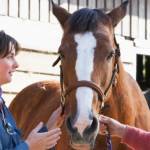Equine Neurologic Exam: What to Look For

Your horse suddenly seems uncoordinated, or his behavior has changed, or he’s having trouble eating. One of his ears is drooping, or he almost fell as he was stepping down over a curb while you were riding him. What’s wrong with him? Your veterinarian might tell you that any of these signs could be related to some sort of neurologic problem.
A veterinarian can tell a lot about a horse’s neurologic condition simply by watching the horse move and interact with his environment. The examination might start with an observation of the horse in a stall or paddock. If the vet sees behaviors like circling, running into things, head-pressing, or seizures, these might indicate neurologic problems, though other causes are possible.
Next, the horse’s head is examined for general position, muscle twitching, eye function, tongue control, ability to chew, and other signs that point to abnormalities. Any obvious injury to the head would be noted at this time.
While the horse is standing still, the veterinarian will examine the horse’s response to touching or tapping at various spots. The horse’s tail control and strength as well as anal tone are evaluated. The vet will check for abnormal sweating, areas of muscle wasting, and any abnormal reflexes or reactions.
The veterinarian can learn more by watching the horse as it is led in circles, asked to turn sharply, moved backwards, and walked forward with its tail pulled to the side. Abnormalities like dragging a foot, stumbling when going up or down a curb, crossing legs, or loss of balance might point to a neurologic problem.
While observation of the horse’s condition can indicate such a problem, more specific diagnostic tools may be necessary before a veterinarian can tell the owner exactly what is wrong with the horse. Physical and behavioral signs help to narrow the field and point toward a likely diagnosis.
Handlers and observers should be cautious when working around a horse suspected of having a neurologic problem. These horses are unpredictable, both emotionally and physically, so anyone near the horse needs to pay close attention to the animal and have an escape route planned.








